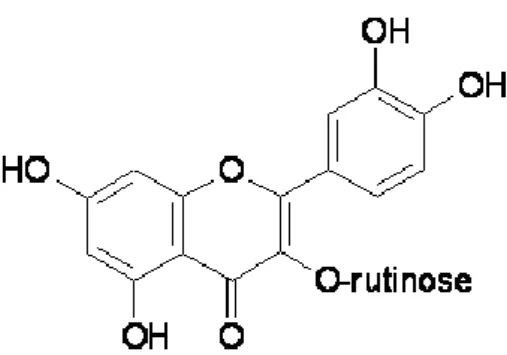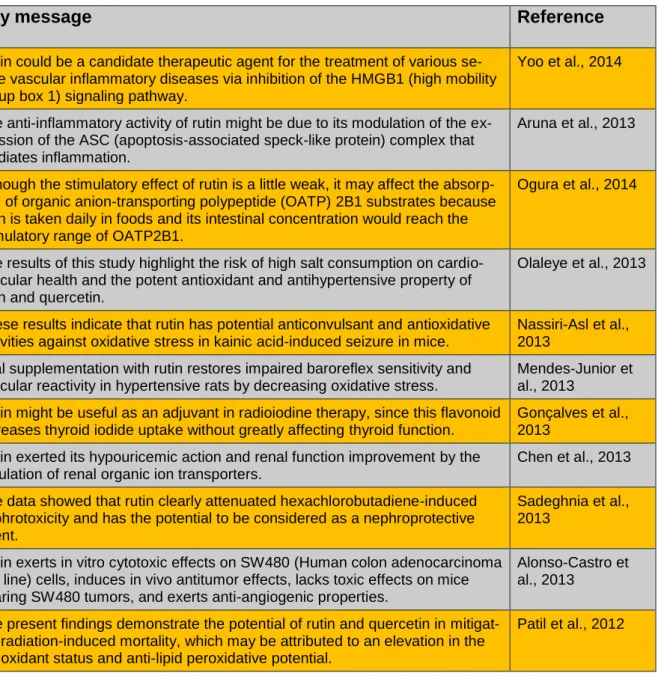Letter to the editor:
AN UP-TO-DATE REVIEW OF RUTIN AND ITS BIOLOGICAL AND PHARMACOLOGICAL ACTIVITIES
Naif Abdullah Al-Dhabi
1, Mariadhas Valan Arasu
1, Chang Ha Park
2, Sang Un Park
2,31
Department of Botany and Microbiology, Addiriyah Chair for Environmental Studies, College of Science, King Saud University, P. O. Box 2455, Riyadh 11451, Saudi Arabia
2
Department of Crop Science, Chungnam National University, 99 Daehak-ro, Yuseong-gu, Daejeon, 305-764, Korea
3
Visiting Professor Program (VPP), King Saud University, P.O. Box 2455, Riyadh 11451, Saudi Arabia
* Corresponding author: E-mail: supark@cnu.ac.kr, Phone: +82-42-822-2631, Fax: +82-42-822-2631
http://dx.doi.org/10.17179/excli2014-663
This is an Open Access article distributed under the terms of the Creative Commons Attribution Licence (http://creativecommons.org/licenses/by/4.0/).
Dear Editor,
Rutin (3,3′,4′,5,7-pentahydroxyflavone-3-rhamnoglucoside: Figure 1) is a flavonoid of the flavonol-type that is widespread in the plant kingdom (Hosseinzadeh and Nassiri-Asl, 2014).
Rutin is synthesized through the phenylpropanoid metabolic pathway, which involves the transformation of the amino acid phenylalanine to 4-coumaroyl-CoA. 4-coumaroyl-CoA can be combined with malonyl-coA to produce the true backbone of flavonoids. The biosynthetic pathway continues through a series of enzymatic modifications to produce rutin (Li et al., 2014).
Rutin has a wide range of pharmacological properties (e.g., antioxidative activity) that have been exploited in human medicine and nutrition. Conventionally, it is used as an antimi- crobial, antifungal, and anti-allergic agent. However, current research has shown its multi- spectrum pharmacological benefits for the treatment of various chronic diseases, such as can- cer, diabetes, hypertension, and hypercholesterolemia (Sharma et al., 2013). Here, we summa- rize the key messages of recent studies performed on rutin and its biological and pharmaco- logical activities (Table 1).
Figure 1: Chemical structure of rutin
Table 1: The biological and pharmacological activities of rutin, as revealed by recent studies
Key message Reference
The present findings demonstrate the potential of rutin and quercetin in mitigat- ing radiation-induced mortality and cytogenetic damage, which may be attribut- ed to the scavenging of radiation-induced free radicals.
Patil et al., 2014
Rutin can induce bone formation via the differentiation of human MG-63 osteo- sarcoma cells. This is the first study to demonstrate the effectiveness of rutin as an osteoblast stimulant.
Park et al., 2014
Rutin may improve endothelial function by augmenting nitric oxide production in human endothelial cells.
Ugusman et al., 2014
Rutin exhibited significant antidiabetic activity, presumably by inhibiting inflam- matory cytokines, and improved the antioxidant and plasma lipid profiles in high fat diet + streptozotocin-induced type 2 diabetic model. Rutin may thus be useful as a diabetic modulator along with standard antidiabetic drugs.
Niture et al., 2014
Rutin protects against the neurodegenerative effects of prion accumulation by increasing the production of neurotropic factors and inhibiting apoptotic path- way activation in neuronal cells. These results suggest that rutin may have clin- ical benefits for prion diseases and other neurodegenerative disorders.
Na et al., 2014
Rutin exerts anti-inflammatory effects in ultraviolet B-irradiated mouse skin by inhibiting the expression of cyclooxygenase-2 and inducible nitric oxide syn- thase.
Choi et al., 2014
Rutin has only a weak and short-term anticonvulsant potential. It appears to be safe for patients with epilepsy because it neither changes the activity of the studied anti-epileptic drugs nor produces any adverse effects.
Nieoczym et al., 2014
Rutin has multi-target therapeutic potential for cognitive deficits associated with conditions involving chronic cerebral hypoperfusion, such as vascular dementia and Alzheimer's disease.
Qu et al., 2014
The study demonstrates for the first time the protective role of two common flavonoids, quercetin and its glycone rutin, against high cholesterol diet (2%)- induced hepatotoxicity and inflammation.
Sikder et al., 2014
Rutin treatment ameliorates the various impairments associated with physical fatigue in a forced swimming mouse model.
Su et al., 2014
Rutin may serve as a potential agent for glycemic control through enhance- ment of insulin-dependent receptor kinase activity, thereby inducing the insulin signaling pathway, and thus causing increased glucose transporter 4 transloca- tion and increased glucose uptake.
Hsu et al., 2014
Rutin may have therapeutic potential for the treatment of neurodegenerative diseases associated with oxidative stress.
Park et al., 2014
Rutin could be effective in reducing neurotoxicity, and its neuroprotective effect might be mediated via antioxidant activity.
Motamedshariaty et al., 2014 Rutin is a promising agent for the treatment of Alzheimer's disease because of
its antioxidant, anti-inflammatory, and β-amyloid oligomer-reducing activities. Xu et al., 2014 Nitric oxide modulation could possibly be involved in the neuroprotective ef-
fects of rutin against head trauma-induced cognitive deficits, neuroinflamma- tion, and apoptotic signaling cascade
Kumar et al., 2014
Table 1 (cont.): The biological and pharmacological activities of rutin, as revealed by recent studies
Key message Reference
Rutin could be a candidate therapeutic agent for the treatment of various se- vere vascular inflammatory diseases via inhibition of the HMGB1 (high mobility group box 1) signaling pathway.
Yoo et al., 2014
The anti-inflammatory activity of rutin might be due to its modulation of the ex- pression of the ASC (apoptosis-associated speck-like protein) complex that mediates inflammation.
Aruna et al., 2013
Although the stimulatory effect of rutin is a little weak, it may affect the absorp- tion of organic anion-transporting polypeptide (OATP) 2B1 substrates because rutin is taken daily in foods and its intestinal concentration would reach the stimulatory range of OATP2B1.
Ogura et al., 2014
The results of this study highlight the risk of high salt consumption on cardio- vascular health and the potent antioxidant and antihypertensive property of rutin and quercetin.
Olaleye et al., 2013
These results indicate that rutin has potential anticonvulsant and antioxidative activities against oxidative stress in kainic acid-induced seizure in mice.
Nassiri-Asl et al., 2013
Oral supplementation with rutin restores impaired baroreflex sensitivity and vascular reactivity in hypertensive rats by decreasing oxidative stress.
Mendes-Junior et al., 2013
Rutin might be useful as an adjuvant in radioiodine therapy, since this flavonoid increases thyroid iodide uptake without greatly affecting thyroid function.
Gonçalves et al., 2013
Rutin exerted its hypouricemic action and renal function improvement by the regulation of renal organic ion transporters.
Chen et al., 2013
The data showed that rutin clearly attenuated hexachlorobutadiene-induced nephrotoxicity and has the potential to be considered as a nephroprotective agent.
Sadeghnia et al., 2013
Rutin exerts in vitro cytotoxic effects on SW480 (Human colon adenocarcinoma cell line) cells, induces in vivo antitumor effects, lacks toxic effects on mice bearing SW480 tumors, and exerts anti-angiogenic properties.
Alonso-Castro et al., 2013
The present findings demonstrate the potential of rutin and quercetin in mitigat- ing radiation-induced mortality, which may be attributed to an elevation in the antioxidant status and anti-lipid peroxidative potential.
Patil et al., 2012
ACKNOWLEDGEMENTS
This project was supported by King Saud University, Deanship of Scientific Research, Addiriyah Chair for Environmental Studies.
REFERENCES
Alonso-Castro AJ, Domínguez F, García-Carrancá A.
Rutin exerts antitumor effects on nude mice bearing SW480 tumor. Arch Med Res. 2013;44:346-51.
Aruna R, Geetha A, Suguna P. Expression of caspase activation recruitment and pyrin domain levels of apoptosis-associated speck-like protein complex in the pancreas of rats subjected to experimental pancre- atitis: Influence of rutin administration. Hum Exp Toxicol. 2013;33:940-8.
Chen YS, Hu QH, Zhang X, Zhu Q, Kong LD. Bene- ficial effect of rutin on oxonate-induced hyperurice- mia and renal dysfunction in mice. Pharmacology.
2013;92:75-83.
Choi KS, Kundu JK, Chun KS, Na HK, Surh YJ. Ru- tin inhibits UVB radiation-induced expression of COX-2 and iNOS in hairless mouse skin: p38 MAP kinase and JNK as potential targets. Arch Biochem Biophys. 2014;559:38-45.
Gonçalves CF, Santos MC, Ginabreda MG, Fortunato RS, Carvalho DP, Freitas Ferreira AC. Flavonoid ru- tin increases thyroid iodide uptake in rats. PLoS One 2013;8:e73908.
Hosseinzadeh H, Nassiri-Asl M. Review of the pro- tective effects of rutin on the metabolic function as an important dietary flavonoid. J Endocrinol Invest.
2014;37:783-8.
Hsu CY, Shih HY, Chia YC, Lee CH, Ashida H, Lai YK, et al. Rutin potentiates insulin receptor kinase to enhance insulin-dependent glucose transporter 4 translocation. Mol Nutr Food Res. 2014;58:1168-76.
Kumar A, Rinwa P, Dhar H. Possible nitric oxide modulation in the protective effects of rutin against experimental head trauma-induced cognitive deficits:
behavioral, biochemical, and molecular correlates. J Surg Res. 2014;188:268-79.
Li X, Kim JK, Park SY, Zhao S, Kim YB, Lee S, et al.
Comparative analysis of flavonoids and polar metabo- lite profiling of Tanno-original and Tanno-high rutin buckwheat. J Agric Food Chem. 2014; 62:2701-8.
Mendes-Junior Ld, Monteiro MM, Carvalho Ados S, Queiroz TM, Braga Vde A. Oral supplementation with the rutin improves cardiovagal baroreflex sensi- tivity and vascular reactivity in hypertensive rats.
Appl Physiol Nutr Metab. 2013;38:1099-106.
Motamedshariaty VS, Amel Farzad S, Nassiri-Asl M, Hosseinzadeh H. Effects of rutin on acrylamide- induced neurotoxicity. Daru. 2014;22:27.
Na JY, Kim S, Song K, Kwon J. Rutin alleviates pri- on Peptide-induced cell death through inhibiting apoptotic pathway activation in dopaminergic neu- ronal cells. Cell Mol Neurobiol. 2014;34:1071-9.
Nassiri-Asl M, Naserpour Farivar T, Abbasi E, Sadeghnia HR, Sheikhi M, Lotfizadeh M, et al. Ef- fects of rutin on oxidative stress in mice with kainic acid-induced seizure. J Integr Med. 2013;11:337-42.
Nieoczym D, Socała K, Raszewski G, Wlaź P. Effect
Niture NT, Ansari AA, Naik SR. Anti-hyperglycemic activity of rutin in streptozotocin-induced diabetic rats: an effect mediated through cytokines, antioxi- dants and lipid biomarkers. Indian J Exp Biol. 2014;
52:720-7.
Ogura J, Koizumi T, Segawa M, Yabe K, Kuwayama K, Sasaki S, et al. Quercetin-3-rhamnoglucoside (ru- tin) stimulates transport of organic anion compounds mediated by organic anion transporting polypeptide 2B1. Biopharm Drug Dispos. 2014;35:173-82.
Olaleye M, Crown O, Akinmoladun A, Akindahunsi A. Rutin and quercetin show greater efficacy than nifedipin in ameliorating hemodynamic, redox, and metabolite imbalances in sodium chloride-induced hypertensive rats. Hum Exp Toxicol. 2013;33:602-8.
Park SE, Sapkota K, Choi JH, Kim MK, Kim YH, Kim KM, et al. Rutin from Dendropanax morbifera Leveille protects human dopaminergic cells against rotenone induced cell injury through inhibiting JNK and p38 MAPK signaling. Neurochem Res. 2014;39:
707-18.
Patil SL, Somashekarappa H, Rajashekhar K. Radio- modulatory role of Rutin and Quercetin in Swiss albi- no mice exposed to the whole body gamma radiation.
Indian J Nucl Med. 2012;27:237-42.
Patil SL, Rao NB, Somashekarappa HM, Rajashekhar KP. Antigenotoxic potential of Rutin and Quercetin in swiss mice exposed to gamma radiation. Biomed J.
2014;37:305-13.
Qu J, Zhou Q, Du Y, Zhang W, Bai M, Zhang Z, et al.
Rutin protects against cognitive deficits and brain damage in rats with chronic cerebral hypoperfusion.
Br J Pharmacol. 2014;171:3702-15.
Sadeghnia HR, Yousefsani BS, Rashidfar M, Bor- oushaki MT, Asadpour E, Ghorbani A. Protective effect of rutin on hexachlorobutadiene-induced ne- phrotoxicity. Ren Fail. 2013; 35:1151-5.
Sharma S, Ali A, Ali J, Sahni JK, Baboota S. Rutin:
therapeutic potential and recent advances in drug de- livery. Expert Opin Investig Drugs. 2013;22:1063-79.
Sikder K, Kesh SB, Das N, Manna K, Dey S. The high antioxidative power of quercetin (aglycone fla- vonoid) and its glycone (rutin) avert high cholesterol diet induced hepatotoxicity and inflammation in Swiss albino mice. Food Funct. 2014;5:1294-303.
Su KY, Yu CY, Chen YW, Huang YT, Chen CT, Wu HF, et al. Rutin, a flavonoid and principal component
Ugusman A, Zakaria Z, Chua KH, Nordin NA, Ab- dullah Mahdy Z. Role of rutin on nitric oxide synthe- sis in human umbilical vein endothelial cells. Sci World J. 2014;2014:169370.
Xu PX, Wang SW, Yu XL, Su YJ, Wang T, Zhou WW, et al. Rutin improves spatial memory in Alz- heimer's disease transgenic mice by reducing Aβ oli- gomer level and attenuating oxidative stress and neu- roinflammation. Behav Brain Res. 2014;264:173-80.
Yoo H, Ku SK, Baek YD, Bae JS. Anti-inflammatory effects of rutin on HMGB1-induced inflammatory responses in vitro and in vivo. Inflamm Res.
2014;63:197-206.
Zhang L, Zhao Q, Chen CH, Qin QZ, Zhou Z, Yu ZP.
Synaptophysin and the dopaminergic system in hip- pocampus are involved in the protective effect of rutin against trimethyltin-induced learning and memory impairment. Nutr Neurosci. 2014;17:222-9.

